You’ll hate me for saying this but, WINTER IS COMING.
Sadly, with winter, comes cold. With cold, comes ice (and white walkers).
With ice, comes slip-and-falls. With slip-and-falls, comes ankle fractures. I’ve unfortunately seen it happen.
As physiotherapists, we are well-equipped to help you return to the things you love after your broken ankle.
This blog post aims to outline a little bit of ankle anatomy (so when the doctor says you broke your fibula, that makes sense), how to know if you need an x-ray, typical healing times, surgical fixes vs. non-surgical fixes, and what you’ll need to work on during the physiotherapy part of your healing!
I will also touch on a few tips to avoid breaking your ankle in the first place (but unfortunately, accidents happen).
Ankle Anatomy: A Refresher
For those of you who follow each and every one of our blogs (Hi, Mom!),
You may remember some basic ankle anatomy from our ‘ankle sprains’ post. If not, here is an outline of the bones that make up our ankle joint:
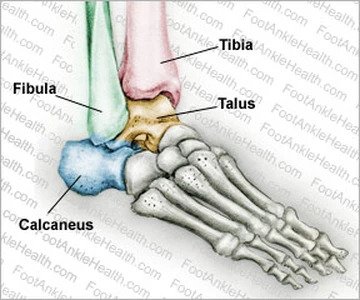
You have two lower leg bones per leg. A tibia (your shin), and a fibula (on the outside of each leg).
Your talus bone sits beneath them, while your calcareous is your heel bone. The bony bump on the outside of your ankle is called your lateral mausoleums (it’s part of your fibula); the bony bump on the inside of your ankle is called your medial mausoleums (it’s part of your tibia).
Most people who have a “broken ankle” break the fibula, the tibia, or both.
Therefore, that’s the assumption I will make when using “broken ankle” for the rest of this blog post.
That being said, it’s important to note that a “broken ankle” can be easily complicated.
You could break your fibula bone, while also rupturing the ligaments and/or muscles on the outside of your ankle, or you could subsequently dislocate from your talus bone.
This blog post is geared towards the more common broken ankles – those that include either just the fibula bone (near the lateral mausoleums), just the tibia bone (near the medial mausoleums), or a combination of both bones.
How do I know if it’s broken? Maybe it’s just sprained…
Again, our avid readers may remember how to know! To determine the need for an x-ray, we use the “Ottawa Ankle Rules”. Here they are:
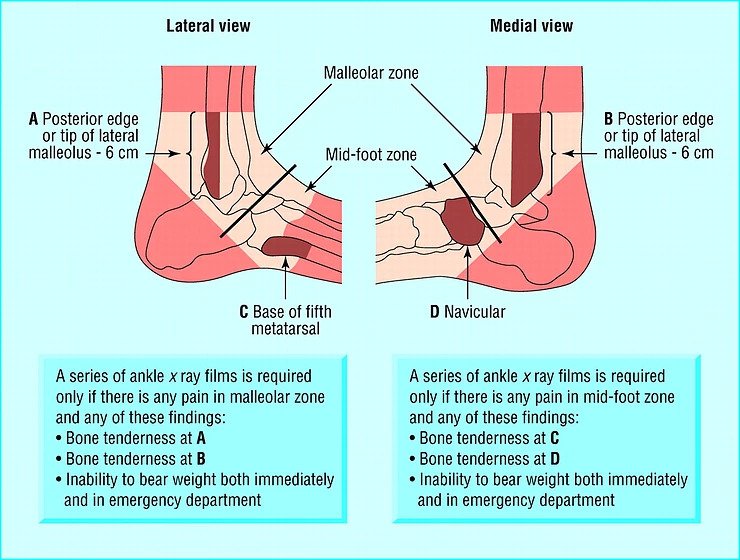
Look at the image above carefully, because it fully explains the rules!
The blue box on the bottom left is referring to ankle fractures, while the blue box on the bottom right is more specific to the foot.
Note: these rules are very accurate for deciding who needs to get an x-ray (meaning, if the test/rules are negative for you, it’s highly likely that your ankle is NOT broken), but their accuracy does decrease slightly when used on those under the age of 18. That being said, if the test/rules are positive, it does not guarantee your ankle is broken, it just means an x-ray is a very wise idea.
If you simply sprained your ankle, head over to our sprained ankle blog post here.
So I definitely broke my ankle, now what?
1. Uncomplicated ankle fractures with no bone displacement
If your x-rays show that you broke your ankle, but the doctors deem it ‘uncomplicated’ or with no bone displacement (the bones broke but didn’t move), then you will likely not need surgery, and you will end up in a cast or air boot (or periods of both) for 4-12 weeks.
I understand that’s a very wide range, but A LOT of things affect this time (read on). In short, if the doctor deems that your fracture is not healing well or just healing slowly, you will be in your cast/air boot for longer.
After your bone heals to the doctors satisfaction, you will be removed from your cast or air boot and sent for physiotherapy.
It’s quite common that you will wean out of your airboot with the help of your physiotherapist. Read on for what that looks like.
2. Complicated, displaced, or unstable ankle fractures
If your x-rays show a more complicated, out-of-place, or unstable fracture, you will consult an orthopedic surgeon, and potentially require surgery to stabilize the broken bones.
The surgeon will use a combination of screws, metal plates, and/or wires to hold your bones together while your body heals itself.
Here’s an example x-ray of what things look like before and after surgery.
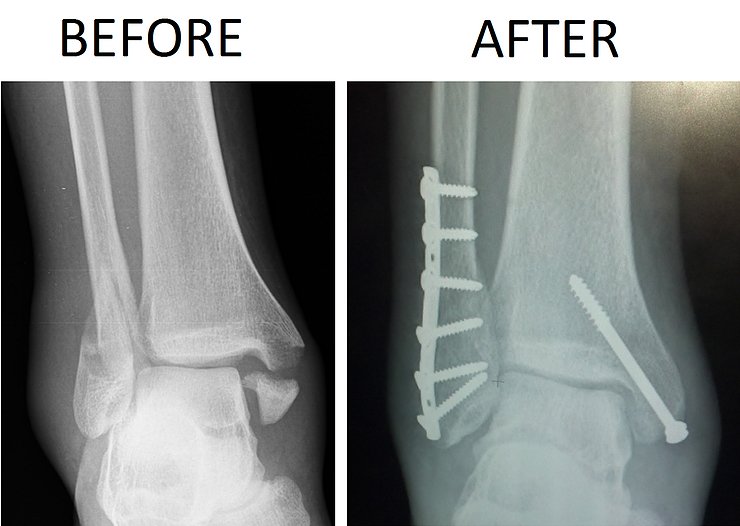
As you can see, the bones on the ‘before’ x-ray don’t appear to be in the right places. The ‘after’ photo shows them back in their proper place, being held together by 7 total screws and a metal plate!
The answer is “no”. They don’t usually take the plate out. Ever. (Of course, there are exceptions to every rule).
After surgery, the process is similar to above (cast–>airboot–>physiotherapy), but you will often have a period of time in which you’re not allowed to put your weight on your leg (surgeon preference, usually 2-6 weeks).
Once your surgeon is satisfied with alignment, level of healing, and the stability of your ankle, you will begin physiotherapy (read on!).
Most of the time, you will follow up with your specialist (orthopedic surgeon) at the 6 week mark after the fracture (to determine readiness for physiotherapy and weaning from the cast/boot), and again at the 3 month mark (to determine need for further intervention).
Additional clarifications and notes:
- Depending on a variety of factors (i.e. doctor preference, stability of your fracture, how well you’re healing), you may be placed into an airboot right away and be allowed to walk around providing you have it on. You may have a hard cast for a few weeks, then transition to an airboot, then out of the airboot. You may be told to put all, some, or none of your weight on your leg (with an airboot on!). You may also have to use crutches to help avoid weight bearing. These things tend to be highly variable, and are determined on a case-to-case basis.
- Most broken bones heal enough to tolerate activity in 6 to 8 weeks. The bone will continue to remodel for up to 2 years, and bones “heal how they’re loaded” (more on that later). Here are some things that might affect how fast your broken ankle heals: – Age (younger typically equals faster healing) – Smoking (smokers typically heal more slowly) – Diabetes (diabetics typically heal more slowly) – Malnourishment (poor diet (or nutrient-absorption illnesses like Crohn’s disease) can slow healing)
Recovery (read: Physiotherapy) of your broken ankle
In most cases, physiotherapy begins between 4 and 8 weeks post-fracture.
If you had surgery, the surgeon may have rules (called “restrictions”) in which you are to follow with your physiotherapist. For example, you may have a “50% partial weight-bearing” restriction until 8 weeks post-op.
This means that you can only put 50% of your weight on your broken ankle. Again, this is highly variable.
Physiotherapy is highly individualized, and your goals, needs, and current abilities will be assessed at your first physiotherapy appointment.
Using this information, your physiotherapist will formulate an individualized program designed to:
- Decrease your pain
- Improve your range of motion
- Improve your balance
- Improve your strength
- Get you back to the things you want/need to do!
They will formulate this plan keeping any restrictions you may have in mind, and everyone is progressed on an individualized timeline!
Roughly, you will progress in this order with rehab:
- Pain control/weaning off the boot (if necessary)
- Range of motion exercises
- Strength building exercises
- Motor control exercises
In many cases, this order is blended, and you’ll be working on multiple types of exercises at once to ensure a slow, progressive, increase in load on your ankle.
“Bones heal in how they’re loaded”. That means that by using your ankle and working the muscles, you’ll encourage your body to better heal your bone!
Your physiotherapist will help you learn an exercise program that accomplishes your goals in the least amount of time, all while trying to limit any negative feelings or complications.
Physiotherapy typically lasts 1-3 months, longer in the cases of complicated surgical repairs.
You may be expected to continue with your exercises on your own to reach a “full recovery” after this time.
A “full recovery” is usually dependent on each individual’s definition of “full”.
Someone who wants to return to soccer at a competitive level needs to learn more tasks (running, kicking a ball, jumping), than someone who wants to return to their once-weekly 30-minute walk.
All that being said, in non-surgical cases, a “full recovery” will take approximately 3-6 months.
In surgical cases, a “full recovery” will take approximately 6-9 months (up to 1 year for more complicated cases).
Safe exercise examples
Once your doctor clears you for rehab/removal of your cast/air boot, it’s okay to start getting your ankle moving.
Here are a few good examples of beginner exercises. Start them right away to encourage a full recovery.
This is a good idea because it might take a few days to get a physiotherapy appointment.
That being said, if your surgeon gave you restrictions, you must keep these in mind!
1. Ankle alphabet
- Draw the letters of the alphabet using your ankle (like your big toe is the pen!). Try to only move your ankle/foot, not your whole leg! Do this 3 times a day!
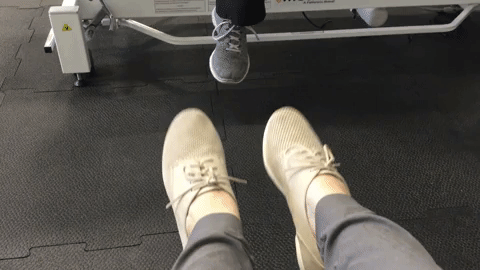
2. Seated heel raises
- Sit with your feet flat on the floor. Press up on your toes, and go back down. Repeat 10 times. Take a break. Then do 10 more times. Do this 3 times a day!
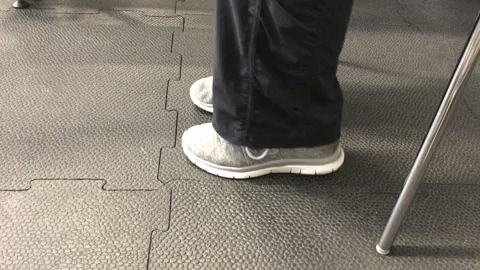
3. Weight shifting *only do this if you feel comfortable, safe, and have no restrictions from the surgeon!
- Stand at a counter where you can hold on for safety. Slowly shift your weight to your injured side (as much weight as comfortable). Hold for 10 seconds. Shift your weight to your uninjured side for 10 seconds. Repeat 10 times. Do this 3 times a day!
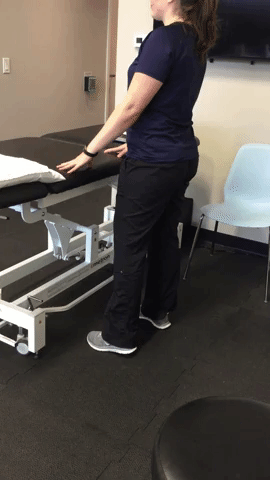
Additional considerations for your broken ankle
A broken ankle is a significant injury, and it may affect other parts of your life.
Here are some other things to consider:
- You may be off work a long time, depending on your job (for example: if you are on your feet constantly doing a lot of squatting and stair climbing, you will be off work much longer than someone with a desk job)
- Physiotherapy appointments will be necessary for at least a month. Yes, the frequency of appointments will decrease over time, but it will be important to stick with your physiotherapy appointments.
- If you have private insurance coverage, that’s great! But keep in mind, depending on how much you have, it is not uncommon to use all of it, and then some.
- If you don’t have private insurance coverage, rehabilitation costs will be expensive.
- Couple this with being off work and finances can be a significant added stress that many people do not consider!
- Be aware of the financial considerations associated with a significant injury
Tips for avoiding slips/falls on ice:
Maintain clean walkways.
- Do your part in clearing all snow and ice. Shovel/snow blow and sand/salt your walkways, stairs, and driveway!
Wear proper footwear
- Get good winter boots with good traction.
Walk like a penguin.
- Bend your knees a little bit and walk flat-footed with your feet turned out a little bit.
- Keep your weight forward, over your base of support.
- Keep your arms slightly outward, walk slowly, and focus on shorter, well-balanced steps!
Practice your strength and balance exercises.
- Maintain good lower body strength and balance. This can be obtained by practicing daily exercises. See a physiotherapist for help!
Conclusion
Do your best to be safe this winter and avoid breaking your ankle!
If however, you have an unfortunate accident, you should now know exactly what steps to take to ensure you reach a full recovery!
Did you break your ankle, and need help recovering? Are you interested in preventing a fall in the first place?
At Strive Physiotherapy & Performance, we are committed to providing an in-depth, one-on-one assessment to ensure we can work together to find the best plan of action for each individual client.
Call us at 519-895-2020, or use our online booking tool on www.strivept.ca to book an appointment with one of our knowledgeable physiotherapists, and they will be sure to help you understand your injury.
Take care,
Tyler Allen
Physiotherapist at Strive Physiotherapy & Performance